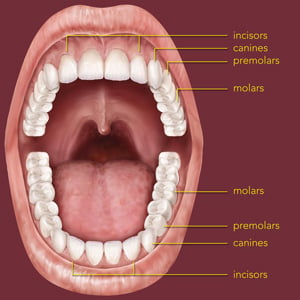Despite their small size, your teeth are actually very complex and constantly changing as you age. In order to properly care for your teeth, it is essential to understand the anatomy of your teeth.
Teeth Contain Layers
 All teeth have three layers: enamel, dentin, and pulp. The enamel is the outermost layer and is primarily made of calcium phosphate minerals. Enamel is the hardest substance in the human body, but it does not grow back once it’s lost. Bacteria can form a biofilm called plaque on the surface of teeth and the carboxylic acids produced by these bacteria can wear down your enamel, causing dental caries (cavities) and sensitivity. To prevent plaque from building up on the enamel and destroying it, remember to brush at least twice a day with a soft bristled tooth brush, floss every 24 hours to disrupt bacterial colonies, use fluoridated mouthwash, and get a dental cleaning every 6 months or as recommended by your dentist.
All teeth have three layers: enamel, dentin, and pulp. The enamel is the outermost layer and is primarily made of calcium phosphate minerals. Enamel is the hardest substance in the human body, but it does not grow back once it’s lost. Bacteria can form a biofilm called plaque on the surface of teeth and the carboxylic acids produced by these bacteria can wear down your enamel, causing dental caries (cavities) and sensitivity. To prevent plaque from building up on the enamel and destroying it, remember to brush at least twice a day with a soft bristled tooth brush, floss every 24 hours to disrupt bacterial colonies, use fluoridated mouthwash, and get a dental cleaning every 6 months or as recommended by your dentist.
Dentin is the middle layer of the tooth and contains both minerals and tubules leading to the pulp. Dentin is nine times softer than enamel. Tooth sensitivity can be caused by anything that exposes dentin, such as brushing too hard, eating acidic foods that dissolve enamel, cracking your tooth, or using too much over–the–counter whitening products that wear down enamel. If you suffer from tooth sensitivity, call your dentist.
Pulp is the innermost and softest layer of teeth. It contains living tissue (blood and nerves) that descends below the gum line along with dentin. If a cavity reaches the pulp, root canal therapy may be necessary to remove the infection and save the tooth. If the tooth can’t be saved, it may need to be extracted.
Parts of the Tooth
 The biting surface of the tooth is called the crown and is important for chewing and speech. The crown is coated with enamel to protect the dentin and pulp from bacteria and stimuli that may cause sensitivity. The root of the tooth descends below the gum line, anchoring the tooth in the gums. The surface of the root is coated in a hard layer of tissue called cementum. On one side of the root, the cementum is attached to the periodontal (gum) ligament. On the other side, the cementum is connected to the dentin. The neck of the tooth is where the crown and root meet at the gum line.
The biting surface of the tooth is called the crown and is important for chewing and speech. The crown is coated with enamel to protect the dentin and pulp from bacteria and stimuli that may cause sensitivity. The root of the tooth descends below the gum line, anchoring the tooth in the gums. The surface of the root is coated in a hard layer of tissue called cementum. On one side of the root, the cementum is attached to the periodontal (gum) ligament. On the other side, the cementum is connected to the dentin. The neck of the tooth is where the crown and root meet at the gum line.
Types of Teeth
 There are also four classes of teeth and all have different functions and structure. Incisors are your front middle four teeth on the top and bottom of your mouth and are used for cutting food due to their chisel shape. Canines are next as you move away from the midline and their pointed shape is useful for tearing into food. After your canines there are two premolars on each side of the mouth on both the top and bottom. Premolars, also known as bicuspids, have two cusps that are used for tearing and crushing food. Finally, your molars are farthest back in your mouth and their multiple cusps are useful for grinding food.
There are also four classes of teeth and all have different functions and structure. Incisors are your front middle four teeth on the top and bottom of your mouth and are used for cutting food due to their chisel shape. Canines are next as you move away from the midline and their pointed shape is useful for tearing into food. After your canines there are two premolars on each side of the mouth on both the top and bottom. Premolars, also known as bicuspids, have two cusps that are used for tearing and crushing food. Finally, your molars are farthest back in your mouth and their multiple cusps are useful for grinding food.
Every tooth in your mouth serves a purpose. It’s important to keep them healthy through proper brushing, flossing, fluoride treatments, and dental cleanings. Call your dentist today at (877) 880-1212 to make an appointment.
Related Posts

Ouch! Toothaches Caused by a Cracked Tooth
Have you ever had a sudden, sharp pain in your mouth when you chew? It may be from a cracked

Decoding Your Smile: Understanding Teeth Names and Their Functions
Welcome to the latest entry in the Coast Dental blog! Today, we’re embarking on an enlightening journey through the human

Top 10 Ways to Keep Kids’ Teeth Healthy
The number of children with cavities is on the rise. Tooth decay now affects more than one-fourth of American children
